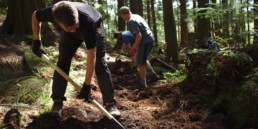Assessing Trail Conditions
Resist the temptation to rush onto the trail, tools in hand, to try to refurbish it. After all, you need to know what the problems are before you can repair them. The following four steps will help you assess your trail’s needs. Also find Parks Canada’s Trail Classification System, which is an excellent tool for trail managers to rate trails, and also plan for future trail management, available for download.
1. Create a Trail Assessment and Repair Sheet.
Repairing a trail all by yourself is tough work, but you can use a trail assessment sheet to direct other people to perform the repair work with you. Trail assessment sheets (like the sample attached below) give you a means of identifying maintenance projects, their locations, the nature of the problems, and a strategy for resolving each situation. You can even list the tools needed and assign a particular work crew and crew leader to tackle each project.
Sure, drawing up an assessment sheet may sound like pen-pusher drudgery, but consider the alternative: You scout a trail, discover several problems that need correcting, and then try to relay that information to your fellow trailworkers without the aid of specific directions. . .
A trail assessment sheet takes the ambiguity out of maintenance work. Feel free to use this version as a model. It’ll take you a couple minutes to create a master and make some photocopies, but when the weekend rolls around and your group of volunteers is standing at the trailhead awaiting orders, your assessment sheets will prevent a lot of confusion.
2. Walk or Ride the Trail.
Once you’ve devised an assessment sheet, it’s time to hit the trail in search of maintenance projects. Take a pedometer or measuring wheel (if walking) or strap a computer onto your bike and start recording your mileage the moment you leave the trailhead.
Whenever you find a spot that needs repair, pull out an assessment sheet, record how far the site is from the trailhead, the nature of the problem, and other information you deem necessary. You may also want to record the severity of the problem. Trail assessment is a lot like performing triage in a busy hospital. You can only tackle so many projects on a given day, so identify and fix the most critical problems first. Consider undertaking sections that pose risk to visitors first and then move on to the sites that will degrade quickly if not corrected immediately.
Step 3: Confer With the Land Manager.
Meet your land manager, if applicable, and discuss trail projects well in advance of scheduling a work day. Here’s where your trail assessment sheets come in handy. They’ll help you accurately explain the problems on the trail and how you plan on resolving them. Save copies of all your assessment sheets so that you can develop a track record of everything you have done to maintain and protect the trail. This is key if you ever need to prove your group’s stewardship credentials.
Step 4: Assign Work Crews.
Assign a leader and work crew of two to five people to each maintenance project. With your assessment sheet in hand, the work crew should be able to answer the following questions:
- Who is on the crew and who is the leader?
- Where is the work site (in meters or km from the trailhead)?
- What tools do we need?
- What is the problem?
- How should we go about repairing the problem?



